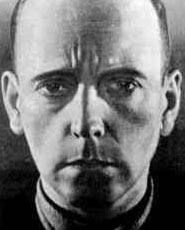John Heartfield and Photomontage
 The work of the man, John Heartfield, is quite clearly influenced by the experiences of the child, Helmut Herzfeld. Young Herzfeld’s talent for art was quickly noticed by those in authority and it helped him earn an education and fledgling career as a commercial artist. By age 25, politics were a driving force behind the art and a name change, to John Heartfield, represented Herzfeld’s aversion to the German politics of the time. Anti-British sentiments were brewing ominously within his homeland and the choice of an anglicized name represented Heartfield’s disagreement with these sentiments. Nationalism growing fervently out of control also alarmed the young artist and his work soon depicted his concern over this extreme sense of patriotism and the Nazi movement that it soon spawned. The work of the man, John Heartfield, is quite clearly influenced by the experiences of the child, Helmut Herzfeld. Young Herzfeld’s talent for art was quickly noticed by those in authority and it helped him earn an education and fledgling career as a commercial artist. By age 25, politics were a driving force behind the art and a name change, to John Heartfield, represented Herzfeld’s aversion to the German politics of the time. Anti-British sentiments were brewing ominously within his homeland and the choice of an anglicized name represented Heartfield’s disagreement with these sentiments. Nationalism growing fervently out of control also alarmed the young artist and his work soon depicted his concern over this extreme sense of patriotism and the Nazi movement that it soon spawned.
Helmut Herzfeld was born in Berlin on June 19, 1891; John Heartfield died in Berlin on April 26, 1968. The life that joined one with the other is tangled with politics, patriotism, and art. Herzfeld’s father, Franz, was a writer specializing in socialism. The child’s mother, Alice Stolzenburg, was a textile worker by day but a political activist during every waking moment. Their political beliefs affected their children with profound effect. Both were convicted of blasphemy when their four children were young. The parents abandoned Helmut; his brother, Wieland; and his sisters, Lotte and Hertha, when they fled Germany to escape prison sentences. After a brief and unsuccessful stay with an uncle, the abandoned children were separated and sent to live in various situations. Helmut was sent to a monastery. His artistic talents were soon obvious and he was allowed to study art. Studies began at the Kongliche-Bayerische Kunstgewerbeschule (Royal Bavarian Arts and Crafts School) in Munich in 1908, where he met Ludwig Hohlwein and Albert Weisgerber, two commercial artists who became strong influences on the young artist’s life. By 1912, Herzfeld was working as a commercial artist, designing book jackets. One project he was assigned was designing covers for a book, The Selected Works of Franz Held. Held, the author, was Herzfeld’s estranged father. In 1914, Herzfeld was drafted into the German army, serving guard duty in Berlin. Coincidentally, his brother, Wieland, had also joined the army and was stationed on the Belgian front. When Helmut received orders to report to front lines, he staged a nervous breakdown and was discharged from the army. Weiland, too, was relieved of military duty before schedule when he was discharged for insubordination. The two rebellious brothers became reacquainted when Wieland moved to Berlin. Gott Strafe England (May God Punish England) was the German rallying cry in 1916, at the height of World War I (WWI). It was at this point that 25-year-old Helmut, so adamantly opposed to such brutal nationalism, changed his name to the more English-sounding John Heartfield. The artist’s experiences in WWI left him so embittered with the German social and political climate that he determined at that point that the only works worthy of being called art were those that exposed social reality. In an act of both defiance and renewal, he destroyed all the work he’d done to that point. 1917 brought Heartfield a wife, Helene Balzer, and 1918 brought them a son, Tom. Also in 1918, Heartfield joined the Berlin Club Dada and the German Communist Party. The Dada movement started in Zurich in 1916 but European events, especially the war, fueled its popularity and soon Dadaist clubs were forming in various cities across the continent, including Berlin. The basic tenet of Dadaism is that it emphasize the absurd and the illogical elements of social conventions changing life in Europe at the time. This mockery of convention relied heavily on collage, montage, and using ready-made objects as the building blocks of the artwork instead of employing the traditional and conventional paint, sculpture, and the like. Heartfield’s preferred medium became the photomontage, for which he took a collection of photographs, trimming away all but the desired element, and then layering together a collection of trimmed photographs to produce the final piece. His work was highly valued by the local Communist Party leaders, who used his images to mock the swastika, that ominous symbol of its political rival, the Nazi Party (National Socialist German Workers’ Party), as well as the Nazi leader, Adolph Hitler. The hand is a common theme among Heartfield’s most well-known works. For him, the hand implied determination and a call for bold action, especially when the hand was represented as a clenched fist, open palm, or with arms raised up in defiance. The aesthetic of chaos, an influence of the Dada movement that began as a reflection of the devastation of WWI, remained apparent in Heartfield’s work as the next war, World War II (WWII), was brewing. Heartfield fled to Czechoslovakia in 1933, when the Nazi Party gained power. He fled again, to England, when it seemed the German army would gain control of the Czech population. When the end of WWII brought a form of peace back to Germany, Heartfield returned to Berlin, where he lived the remainder of his life. He continued his photomontages and delved into filmmaking, too, but it was his earlier works, before WWII, that best display the fiery and radical passion of this highly political artist. Heartfield’s highly popular work elevated photomontage to a newly accepted art form that remains in demand today. The very popular graphic art software program, Photoshop, is based on photomontage and many musicians use Hearfield’s art to illustrate their album covers, especially when the band or album is of a politically edgy nature. To learn more about this highly influential artist, visit these website: - Self Portrait: Scroll down to find a very telling photographic self-portrait of the artist.
- The Differences Between Photomontage and Collage: Although they seem similar, collages and photomontage are different art forms.
- Berlin: The City as Body, the City as Metaphor: Although photomontages can seem randomly pieced together at first glance, Heartfield’s art was nothing if not deliberate and designed to shock.
- “A Hand Has Five Fingers:” This election poster, advocating the communist party in 1928, reads in English, “A hand has five fingers; with five fingers you can catch the enemy.”
- Heartfield’s Online Art: Towson University offers many online images of Heartfield’s work as well as information about the musical and educational resources, including lesson plans and a glossary.
- Dada (1916 - 1924): Some authorities consider Heartfield one of the five most important contributors to the Dadaist art movement.
- The International Dada Archive: The University of Iowa founded this “comprehensive collection of documentation and scholarship relating to Dada” in 1979.
- Agitated Images: The J. Paul Getty Museum presented a very impressive collection of Heartfield’s work in 2006.
- Prussian Archangel: Heartfield’s collaboration with Rudolf Schlichter is said to be an explicit representation of the politics of “Club Dada.”
- Heartfield and Goldman Sachs: Even as executives for the investment giant, Goldman Sachs, are being brutally grilled before Congress, graphic artists are using Heartfield’s images to express outrage with today’s current events.
This article was written by Mike Haldas, co-founder and managing partner of CCTV Camera Pros. If you found it useful, please share it.
| Shop for video surveillance products |
|---|
| | | |
|---|
|









 The work of the man, John Heartfield, is quite clearly influenced by the experiences of the child, Helmut Herzfeld. Young Herzfeld’s talent for art was quickly noticed by those in authority and it helped him earn an education and fledgling career as a commercial artist. By age 25, politics were a driving force behind the art and a name change, to John Heartfield, represented Herzfeld’s aversion to the German politics of the time. Anti-British sentiments were brewing ominously within his homeland and the choice of an anglicized name represented Heartfield’s disagreement with these sentiments. Nationalism growing fervently out of control also alarmed the young artist and his work soon depicted his concern over this extreme sense of patriotism and the Nazi movement that it soon spawned.
The work of the man, John Heartfield, is quite clearly influenced by the experiences of the child, Helmut Herzfeld. Young Herzfeld’s talent for art was quickly noticed by those in authority and it helped him earn an education and fledgling career as a commercial artist. By age 25, politics were a driving force behind the art and a name change, to John Heartfield, represented Herzfeld’s aversion to the German politics of the time. Anti-British sentiments were brewing ominously within his homeland and the choice of an anglicized name represented Heartfield’s disagreement with these sentiments. Nationalism growing fervently out of control also alarmed the young artist and his work soon depicted his concern over this extreme sense of patriotism and the Nazi movement that it soon spawned.
